 Leading Blog | Posts by Month |
 Leading Blog | Posts by Month |
11.30.19

LeadershipNow 140: November 2019 Compilation
See more on
Posted by Michael McKinney at 08:16 AM
11.28.19

Happy Thanksgiving from LeadershipNow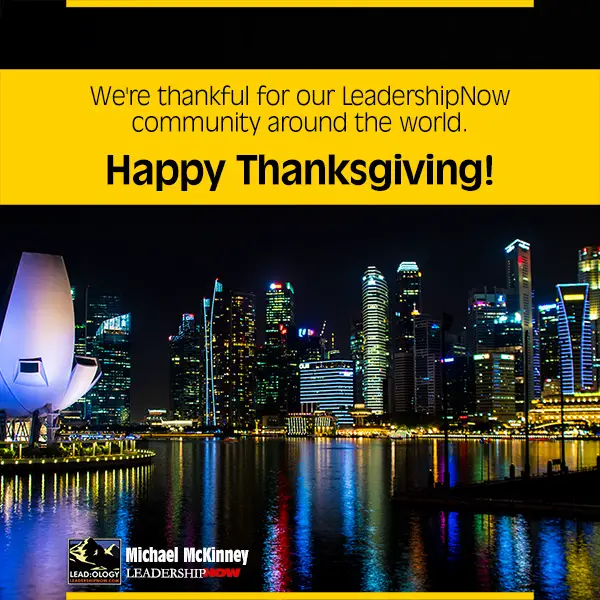
W Happy Thanksgiving! We owe so much to so many. It was Albert Schweitzer who said, “At times, our own light goes out and is rekindled by a spark from another person. Each of us has cause to think with deep gratitude of those who have lighted the flame within us.” Thank you! Here are links to posts on gratitude from here and around the web:
Posted by Michael McKinney at 12:59 PM
11.25.19

Hiring for Cultural Fit
ORGANIZATIONS OFTEN TALK about hiring for cultural fit, yet very few of them know how to do it well. This is mostly because they haven’t taken the time to define their culture and, therefore, there’s nothing to hire against or fit into. Instead, a standard set of questions, technical skills, qualifications, and psychometric testing are used in the hope that the right candidate lands in their lap. Where time, money and effort has been invested to define the organizational culture, it’s imperative to use what that definition to bring in the kind of people who will contribute to it, rather than hold it back. The hiring process isn’t an exercise in finding someone with a pulse to fill a position. It’s an opportunity to bring in an individual whose values, intention, mindset, and ambition match that of the organization. Quite often, the most qualified person isn’t the right person for the culture you’ve created. However, it may take one, two, or seven interviews to determine that. In order to ensure that a force for good is added to the organizational culture, time needs to be taken to execute the hiring process well. That way, the person fully understands what’s expected to fit into the culture and the environment in which the work gets done. When the new hire meshes well with these expectations, unnecessary performance management time is avoided. Case studies of how to hire for culture successfully Tony Hseih, CEO of the online shoe retailer Zappos, once famously said that he didn’t know anything about shoes, but knew a lot about creating workplace culture. Zappos has a very well-defined recruitment and induction process, which it calls The Zappos Family New Hire Program. It’s not a rubber-stamping probation period, but a values fit assessment. Every new hire, regardless of role or department, goes through the four-week program, which combines technical training and culture immersion. In the end, the employee has full knowledge of what the organization stands for and how it does business, and the organization can assess the mindset of the individual and how he or she can contribute to Zappos’ values. When hiring at Slack, CEO Stewart Butterfield looks for humility and an acknowledgment that luck has played some part in the job prospect’s success. He also places great emphasis on diversity: “If you don’t have people who come from different backgrounds and experiences, you’ll miss out on meeting the needs of groups of customers.” Ben Kirshner, former CEO at Elite SEM and now Chairman of the Board at Tinuiti, said he’s very particular about who he brings into the culture. , means interviews, on core values. Using an example of having an attitude of gratitude, he explained, “The hiring team will ask candidates a lot of questions to gauge how grateful a candidate is -- how much they appreciate others and how much they give back.” If organizations such as Zappos, Slack, and Tinuiti hired people who didn't share their values, then their culture would become stagnant very quickly as these people would drag others down. Just because they’re qualified doesn’t mean they’ll fit To hire for cultural fit, it’s critical to assess not only an interviewee’s technical skills but also how well the values, emotional skills, and aspirations complement the organization’s culture. To uncover those attributes that can enhance company culture, apply these hiring strategies: 1. Use the organization’s vision statement as a hiring tool. Part of defining company culture is creating an inspirational statement of intent that generates the impetus for moving beyond the status quo. The vision statement can also become a tool for hiring as you determine whether the individual will improve the organization’s chances of achieving its vision. People are often attracted to cultures based on their aspirations. It’s a great way to check that potential employees share the same dreams and understand the agreed-upon ways of working together to realize them. 2. Look beyond a candidate’s skills. While skills may get them an interview, the candidates’ emotional intelligence should be a determining factor in who gets the job. That means the interview should be structured to ensure that emotional intelligence is something you uncover. One valuable question to ask is, “Tell me about your biggest failure.” Being able to admit fallibility is important in a collaborative environment. Also, the best candidates will share how they’ve adapted or changed from the experience. 3. Tailor questions to find out a person’s values. The aim of the interviewing process is to separate those that understand what they stand for from those who just want a job and will say want they think the interviewer wants to hear. Ask candidates to describe their values and how they live them on a day-to-day basis. Include questions around how the candidate would apply the organizational values and remain resilient in stressful situations. 4. Investigate cultural fit. Understand the personalities and skillsets that you already have on board. Once you know your team, and you’ve collectively developed your defined culture, you can look for someone with the right values, personality, and skills to fill the gaps. Hiring any member of staff, regardless of whether they’re permanent or contract, shouldn’t be rushed. If you don’t want to undermine the culture that you have, then it’s important to take the time to find someone who will add to it. Those people will fit like a glove. 
Posted by Michael McKinney at 08:33 AM
11.22.19

Empathy-Driven Leadership: How to Be Compassionately Competitive in a For-Profit World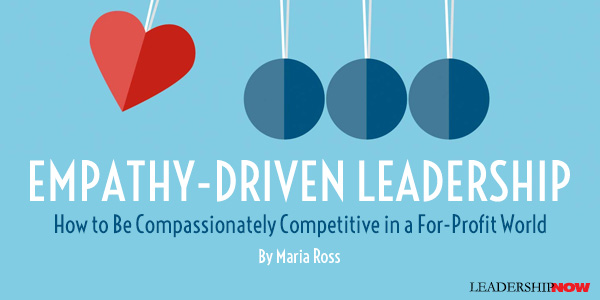
EMPATHY? Isn’t that for directors of nonprofits and starry-eyed Millennial entrepreneurs with idealistic dreams? What good is empathy in an uber-competitive, saturated marketplace where leaders need to capitalize on every opportunity to stand out? The Empathy Edge definitively answers these questions showing how for-profit leaders can use empathy to gain the upper hand. Contrary to popular belief, compassion and empathy are actually huge assets in the business world. What if leaders could shift the cultural mindset around what gives businesses a competitive advantage and recognize the benefits of being more human? Not only would they build smarter businesses, connect more deeply with their customers, and become stronger leaders, but also maybe, just maybe, our world could become a little bit better. This is an interesting proposition. Leaders are in a position to influence how we think about the relationship between empathy and industry. Still, a sea change like this is hard-won. So, what’s in it for the leaders themselves? Benefits of Empathetic Leadership When you start to explore the benefits of empathetic leadership on a deeper level, it becomes difficult to see empathy as anything other than essential for competent leadership. Highly empathetic people (or HEP’s) recognize the pain and suffering of others as a problem in need of a solution. This is the foundation of every good business model. Further, without empathy, leaders can’t build a team, inspire followers, or elicit loyalty. Among the benefits that come to empathetic leaders, whether they are entrepreneurs or c-suite executives, are the following:
The benefits of empathy for individual leaders are many, and this list likely only scratches the surface. But it’s clear that empathy is a core leadership skill. Now you may be wondering what it takes to be (or become) an empathetic leader. You may recognize empathy as an innate human trait, and as with all human traits, there is a spectrum of strengths and weaknesses. Some of us are naturally “gifted” when it comes to being able to relate to others’ experiences, while others are naturally lower on the empathy scale. The good news is—no matter where you find your natural tendency—empathy, like other leadership skills, is something we can learn, cultivate, develop, and teach to others. In the book, you will find seven simple ways to train yourself to lead more empathetically. Here are four of the most actionable steps you can take: 1. Practice Presence. When you feel constantly scattered and spread too thin, it may seem like you can’t find even five minutes in your busy workday to take a break. But if you can’t ground yourself, how can you expect to be able to consider others’ perspectives? When you’re present with yourself, you’ll have a fighting chance of being present with others. Create space for a daily practice of meditation or simply sitting in silence. Even a few minutes will help. 2. Listen More, Stay Humble. Empathy requires a mind that is open to listening to people’s experiences, stories, and perspectives. When you really listen, you aren’t tempted to jump in and offer advice or make demands. Instead, the tendency is to pause and look for patterns before providing relevant feedback. Empathetic leaders embody a servant’s mindset staying humble and looking for common ground with colleagues, employees, and customers. 3. Be Curious. The ability to put yourself in the shoes of those you’re leading requires being genuinely curious about where they’re coming from. Authentically empathetic people have never met another person from whom they couldn’t learn something. As a leader who may be tasked with teaching others, it’s easy to feel disconnected from the part of yourself that is constantly curious. But if you look carefully, you’ll find it’s still there. Reconnect with your curious inner child, stay open, and watch opportunities come your way. 4. Get in the Trenches. Empathetic leaders are hungry to understand their staff better. There’s no better way to understand someone else than by standing shoulder-to-shoulder with them and experiencing exactly what they experience. If you deem a job “beneath” you or a “waste of your time,” consider the message you’re sending to those doing this job. Try a colleague’s job, work the customer support phones, or go on a sales call. You’ll be surprised by what you learn about your company, your employees, and yourself.  The Empathy Edge expertly weaves together engaging stories and compelling interviews with leaders who embody empathetic leadership. Maria Ross’s talent as a storyteller is rivaled only by her ability to offer straightforward, practical steps for executives and brands that want to increase productivity, find financial success, and integrate emotional intelligence. The big takeaway: when empathy and compassion lead, incredible success—both professional and personal—follows.
Posted by Michael McKinney at 07:45 AM
11.21.19

James Mattis: My Favorite Books
GENERAL JAMES MATTIS credits his leadership success to his prodigious reading habits. He says, “You stay teachable most by reading books, by reading what other people went through.” Admiral James Stavridis is also an avid reader and believes that reading is central to leading. Reading lists are personal, but they do provide a guide as to what others have read to improve their leadership and their understanding of the human condition. In Call Sign Chaos, James Mattis writes: Reading is an honor and a gift from a warrior or historian who—a decade or a thousand decades ago—set aside time to write. Non-Fiction
Biographies
Fiction
This list is available as a PDF.
Posted by Michael McKinney at 06:49 AM
11.20.19

General Jim Mattis on Learning to Lead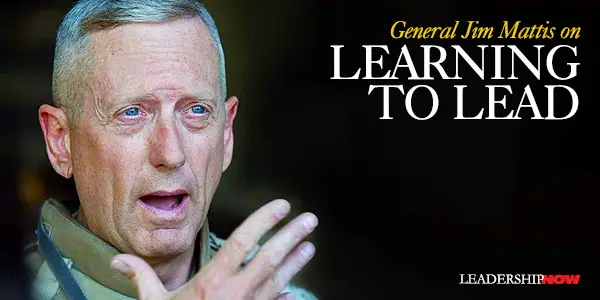
IT’S NOT SURPRISING that we learn a lot about character from the military. Good character is mission-critical. Under extreme circumstances, if you don’t have good character, the result is extremely bad consequences. In war, character is not a platitude. Good character development is evident in Call Sign Chaos. Written by Jim Mattis and made better with the help of Bing West, the book details the lessons Mattis learned from more than 40 years in the Marine Corps. He organizes the book in terms of the changing nature of his leadership responsibilities as he moved up the ranks. First, he learned face-to-face or direct leadership. At a time when, “alongside those I led, I had a personal, often intense bond with troops I frequently knew better than my own brothers.” Next, he discusses executive leadership, where commanding a force of 7,000 to 42,000 troops, it was impossible to know them all individually, so communications and leadership styles must adapt. Finally, he covers the challenges and techniques relevant to strategic leadership from a senior military officer’s perspective. (His call sign, CHAOS, was given to him by his operations officer, John Toolan.” It stands for, “Does the Colonel Have Another Outstanding Solution?” “There’s always a Toolan, “he writes, “waiting out there to keep your ego in check, providing you keep the risk-takers and mavericks at your side.”) As is commonly done, a book is a good place to settle scores and vent your opinions. Although Mattis resigned halfway through his appointment as Secretary of Defense at the end of 2018, he writes, “I’m old-fashioned: I don’t write about sitting presidents.” “Old-fashioned” is often another way of saying character. Importantly, he talks about the challenge of communicating the commander’s intent. When commanding a large number of troops or a large organization, a leader must be able to communicate their intent in such a way as to allow people to act. It requires discipline and trust. Developing a culture of operating from commander’s intent demanded a higher level of unit discipline and self-discipline than issuing voluminous, detailed instructions. It highlights the need for clear and consistently enforced values to guide teams and organizations. Commander’s intent provides a framework that everyone can operate from. Mattis also mentions the need to get inside the enemy’s OODA loop—to adapt faster than they could. The OODA loop is a concept developed by Colonel John Boyd and stands for observe–orient–decide–act. In uncertain and changing environments, one can gain the advantage if they can ensure that their OODA loops are functioning, as Mattis puts it, “at the speed of relevance. It is possible then, to get inside the enemy’s OODA loop. This is made possible, in part, by having the commander’s intent clearly communicated and understood. The OODA loop helps us to shift our perspective from what we want things to be to what they are in reality. A common organizational problem. Our campaign’s success was based on not giving the enemy time to react. To win a dogfight, Boyd wrote, you have to observe what is going on, orient yourself, decide what to do, and act before your opponent has completed his version of that same process, repeating and repeating this loop faster than your foe. Call Sign Chaos has actionable ideas throughout for any team. What follows are quotes taken from the book that will give you a flavor for what is addressed here: The Marine philosophy is to recruit for attitude and train for skills. Marines believe that attitude is a weapon system. 
Posted by Michael McKinney at 07:51 AM
11.19.19

quickpoint: Leaders Build Faith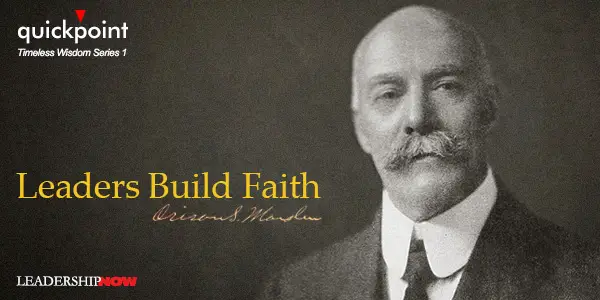
THE JOB of a leader is to build faith. The New Testament says that faith is confidence in what we hope for and conviction about what we do not see. It is the confident assurance that something we want is going to happen. In short, faith is the belief in the realization of vision. Jonathan Swift said that “vision is the art of seeing the invisible.” Faith is the belief that it will happen. The process is to separate the important from the peripheral—to lift people from their present reality to a future possibility. Embracing a vision is an act of faith. Without it, there is no reason to pursue it. Faith is like trust and based on it, but I would suggest that it is more than that. Faith is trust infused with passion. It drives us forward. Faith changes our behavior generally and how we interact with others specifically. While virtually invisible, faith is powerful. It is what brings life to leadership relationships. Leaders with great power also have great faith and build that faith in others. Orison Swett Marden, author, and founder of SUCCESS magazine elaborates on the importance of faith in any endeavor: Faith is the best substitute for genius; in fact, it is closely allied to genius.
Posted by Michael McKinney at 08:44 AM
11.15.19

The Relationship Economy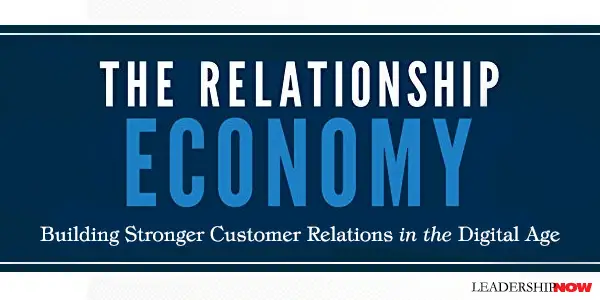
THE ONE SKILL that matters more than any other in leadership and life is the ability to connect with others. We generally learn this through example, but if those we emulated didn’t know how to do it (or its importance), we are at a disadvantage. It is, unfortunately, one skill that is rarely taught in any formal way. While technology has made connecting easier and more convenient it has also “changed the way we communicate, behave, and think,” writes John DiJulius in The Relationship Economy. This has led us to a “dramatic decline in our people skills. The pendulum has swung over to high tech and low touch.” A study by the Relational Capital Group revealed that 89 percent of senior leaders believe that relationships are the most important factor in their success year over year. However, the study also revealed that only 24 percent of those leaders actually do anything intentionally to promote building those relationships. Finally, the study further indicated that less than 5 percent of organizations actually have any specific strategies for helping the professionals develop and strengthen the relationships required to achieve their goals. That’s where DiJulius and The Relationship Economy come in. “The Relationship Economy is about building a culture that recognizes the importance of each individual and making everyone a part of a community that is working toward something bigger—a community that makes them feel cared for.” Hospitality entrepreneur Chip Conley said in a TED talk that “Almost 40 percent of us in the U.S. workforce have a boss that is younger than us and that number is growing quickly. Power is cascading to the young like never before because of our increasing reliance on digital intelligence. We are seeing young founders of companies in their early 20s scaling them up to global giants by the time they get to 30. And yet we expect these young digital leaders to somehow miraculously embody the relationship wisdom we older workers have had decades to learn. It’s hard to microwave your emotional intelligence.” We need a plan, and this is an easy place to start. After we meet someone, we can begin by learning at least two facts about their FORD—that is, their Family, their Occupation, their Recreation, or their Dreams. It’s not about grilling your customers and coworkers, but genuinely showing interest in them as part of the natural flow of conversation. Listening is a skill we need to develop. (Common and often unintentional mistake: “Never steal someone’s thunder. Suspend your own ego and let them enjoy their own story. This is a tough one for many because when someone brings up something that you have in common, you can get excited to share your experience.) DiJulius offers seven traits for effective communications and explores them throughout this book. You will also find ways to track interactions in your organization. 1. Compassion and Empathy — “Highly empathic people have an insatiable curiosity about strangers.” 2. Engagement and Warmth — Employees who love what they do put customers at ease. Smile. 3. A Drive to Serve — Focus on the customer and the experience they are having. How do they feel after their encounter with you? 4. Ownership — Acting with the same care as the owner of the company would. Do what it takes to ensure a happy customer. 5. Charitable Assumption — Always assume the best in people. 6. Presence — Be in the moment. Do not allow distractions. DiJulius says, “Carpe Momento: seize the moment. There is no better motto for reminding us that any connection with others—especially building relationships—depends on being fully engaged with them.” 7. The Desire to Exceed Expectations — Like a drive to serve, always be looking for ways to go above and beyond other people’s expectations. It’s always about building relationships. “Strangers are where your greatest opportunities lie—they’re future connections, friendships, resources, experiences, laughs, and good times.” No one succeeds alone. 
Posted by Michael McKinney at 08:07 AM
11.13.19

5 Steps to an Aligned and High-Functioning Organization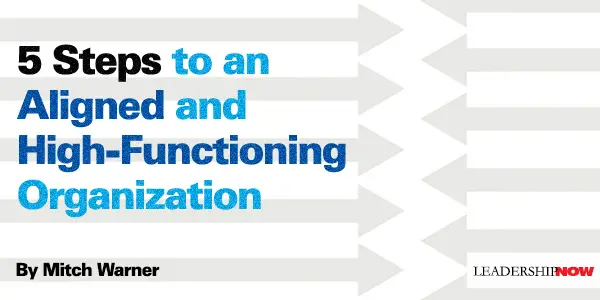
IN OUR WORK training and consulting organizations across the globe, we have found misalignment to be at the heart of most organizational dysfunction. People assume the organization’s goals are clear to everyone and that employees’ roles and priorities are aligned to support those goals. However, most of the time they’re not. This misalignment causes all kinds of problems. Managers get upset because the things they think are important aren’t getting done. Employees get upset because they’re not getting the support they think they should be getting. And massive amounts of time and energy are wasted as a result. It’s not that anyone has ill intent. It’s just that they haven’t aligned on goals, roles, and priorities. Here are 5 steps to create this alignment in an organization: 1. Lead the shift to an outward mindset No leader, no matter how brilliant their argument or how pressing the bottom line, will be able to enable alignment in an organization that’s locked in an inward mindset. With an inward mindset, we are self-focused. We see only our own needs, challenges, and objectives. By contrast, an outward-mindset culture enables all to envision and pursue a collective result. With an outward mindset, people focus on achieving their goals in context, with a clear understanding not only of how their actions contribute to collective results but also how they are impacting others’ abilities to contribute. As a leader, you need to spearhead the shift to an outward mindset by focusing on the collective result, your role in it, and how you’re impacting others. As you honestly hold yourself accountable for your impact on others, you model that change—and walking the walk will invite people to follow your lead. 2. Lead your teams’ shift to an outward mindset Too often, people in organizations primarily identify around their separate, individual roles. With an outward mindset, teams and team members break free from the constraints of self-focus and are able to see options that would not otherwise occur to them. The basic ways they see the world are different: with an inward mindset, people tend to see each other as objects; with an outward mindset, they see each other as people. Instead of acting in ways calculated to benefit or justify themselves, they take into account their impact on others and adjust their efforts to be more helpful. They consider others’ needs and behave in ways that further the collective results they are committed to achieving. 3. Articulate the collective result An organization needs to be explicitly organized around a result in order to achieve it. Take the case of Gregg Popovich and the San Antonio Spurs. Not surprisingly, this NBA team and their coach are all about championships. And winning a championship isn’t yet the kind of objective that sets up an organization to work in an outward-mindset way. Chasing that dream can be done in inward-mindset ways as well. But Popovich led his team to shift to an outward mindset in order to better achieve a specific collective goal: winning through ego-less teamwork—a result that requires everyone to be all in. This collective goal informs how they pursue each championship, and the results tell the story. The team appears to operate as a single organism on the court, with no ego on the floor that would prevent the most advantageous moves. This approach also means the team can prevail despite personnel changes. 4. Show people how they play a role in the collective result Wherever people are organized together, a collective result already exists, just waiting to be named, collaborated around, and worked toward. But people need to grasp the importance of their own roles in the overall collective result and see how their work will contribute to the end results. When people not only understand the collective goal but have a clear sense of their own importance in it, they have the clarity and confidence to act on their own initiative. 5. Ask these questions Invite people at all levels of the organization to ask the following questions. These questions will help everyone redefine their own role in achieving the collective result, and accelerate the shift to an outward mindset. • Toward my manager: Do I have a clear understanding of my manager’s objectives? What can I do to learn about them? What do I need to do to make sure I am holding myself accountable for my contribution to my manager’s results? Who do I need to work with to ensure that I help my manager achieve those results? • Toward customers: Who are my customers, and what objectives do they have that I could help with? How will I measure whether they are, in fact, helped by my efforts? • Toward peers: Which of my peers are affected by my work? What are their objectives? Do I know whether I am helping or hindering them in their ability to accomplish their objectives? • Toward direct reports: Are my direct reports growing in their abilities? Have I worked with them to set a collective result for the entire team, and do they understand how they contribute to that result? Do they understand how their work impacts the ability of others to make their contributions to the collective result? And are they holding themselves accountable for that impact in each of the directions of their work? What can I do to help them to do this? By clarifying the collective result, leaders encourage individuals and teams to improve their contributions within the organization—without waiting for directives from those with a broader view of the organization’s interconnected parts. Equipped with this understanding, people don’t need someone else to align their roles relative to others. They can do it themselves. They know how their actions contribute to accomplishing the collective result and can constantly adjust to achieve a better outcome. They decide to be this kind of contributor—and that’s when the true power of teams is unleashed. 
Posted by Michael McKinney at 08:39 AM
11.11.19

quickpoint: He Can Who Thinks He Can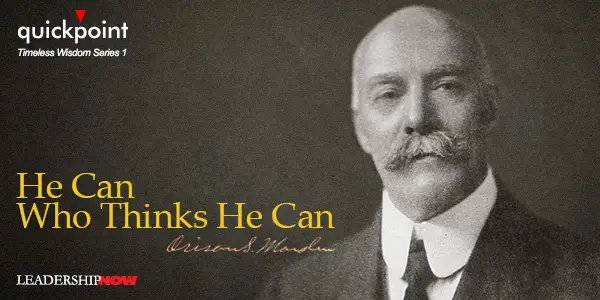
WE ALL POSSESS some confidence, but we all could use more of it. Confidence is about managing your self-doubt in order to do what you need to do to achieve your long-term goals. Confidence is a matter of mindset and belief and is reinforced by action. A chief characteristic of confident people is resilience—the ability to bounce forward in the face of struggle or disruption. Our thoughts matter. As the old saying goes, success breeds success. As we act in spite of our doubts, we build the confidence to carry on. Doubt creates even more paralyzing doubt. It is a vicious cycle you want to avoid. Fear and doubt are countered by positive thoughts and a belief that we will succeed if we try. Confidence can morph into arrogance. And we want to avoid that because it limits our potential. It puts a lid on our growth. What helps us to prevent arrogance is teachability. Teachability is the understanding that there is always more going on than we think. Curiosity suppresses arrogance. Orison Swett Marden, author, and founder of SUCCESS magazine writes this about defeating fear and doubt in his 1908 book, He Can Who Thinks He Can: How long will it take a person to become successful who puts themselves in an atmosphere of failure and remains in it until he or she is soaked, saturated, with the idea? How long will it take a person who depreciates themselves, talks failure, thinks failure, walks like a failure and dresses like a failure; who is always complaining of the insurmountable difficulties in their way, and whose every step is on the road to failure, how long will it take them to arrive at the success goal? Will anyone believe in them or expect them to win?
Posted by Michael McKinney at 07:49 AM
11.08.19

Is a Lack of Intentionality Holding You Back?
WHAT ARE the defining characteristics of successful leadership? Mark Sanborn identifies them as clarity and intentionality in The Intention Imperative. Clarity, he says, “tells you where you’re headed” and intentionality is “the consistent action you’ll take to get there.” To explain, Sanborn takes us back to when Domino’s found clarity and discovered how they were going to get there. With clarity of purpose that took them back to their roots, and intentionality, they became an e-commerce company that happens to sell pizza. As a result, Dominos stock has risen 5000 percent since 2008, outperforming all of the world’s largest tech companies. Leading with clarity and intentionality makes the difference. He offers the following chart to illuminate the effect of clarity and intentionality on our leadership effectiveness.
The quadrant of No Leadership is negligent leadership—no direction and no way to get there. Vague Leadership has a bias for action but lacks a clear idea of where they’re going. Wishful Leadership knows where they want to go but haven’t figured out the how or aren’t taking consistent action to get there. Intentional leadership is effective leadership. “Intentional leadership is knowing where you want to go and taking consistent action in the world as it is, not the world as it was, to get there.” There is a lot contained in that last statement and is the subject of this book. Intentional Leadership consists of three imperatives: Inspiration, Culture, and Emotion. The Culture Imperative Culture gets a lot of attention and is considered critical to success, but few organizations actually do much about it. At best, it becomes an HR function. Sanborn defines culture as “what we think and believe, which then determines what we do and what we accomplish.” He lists six reasons why it matters so much, but this reason caught my attention. I had never looked at it from this perspective. He says, “Culture is a corporate immune system that protects against variance, decline, or abandonment by identifying and combating threatening forces like toxic partners, disjointed processes, and bad decisions.” Culture often takes a back seat—though we know better—because we focus on the wrong things or think it is all about making employees happy. “Making people happy isn’t the job of an intentional leader. The job of an intentional leader is giving employees the tools—the philosophy, the training, the communication, and the incentives—to be successful.” Sanborn offers five levers to create, change, and/or maintain culture—intentionally. The Inspiration Imperative Inspiration comes from purpose and the mission. It’s more than motivation or engagement which are “task-focused and lack the sustaining power of inspiration.” Inspiring leadership begins with you. You find it in yourself first so that you can bring it out in others. Inspiration can be found in solitude, those you associate with, curiosity, a healthy sense of humor, gratefulness, service and exercise. “To find your purpose is to find your inspiration.” From this foundation you can guide others to their inspiration. Sanborn offers ten tools for inspiration. Connection with your team, your example, empathy, linking purpose to work, providing challenges and education, appreciation, and a good story are among the ten. The Emotion Imperative We have entered the emotion economy. The customer wants to feel successful after the fact, not just happy. “Are you happier you did business with us than with someone else?” You want customers happy they chose you—to feel successful. “The old notion that a company merely needs to provide a good or service withers away when we start to understand that it is not the product or service itself that matters—what matters is which emotion your company elicits from its customers.” The intentional leader knows that this goes beyond customer service. That’s part of it. “A customer’s emotions start well before they enter your sales funnel. The new economy has expanded the points at which your potential customers will first interact with your company. Across all levels of your organization, ask yourself how each impacts the customer’s happiness and feelings of success. This includes marketing, product design, sales, and, yes, customer service.” There are a lot of great insights in this book. Through a series of case studies that go beyond the usual suspects—a parking garage, High Point University, Acuity Insurance, Savannah Bananas baseball, Texas Roadhouse, and Envisioning Green landscaping—and interviews, he walks us through the thinking behind intentional leadership and its three imperatives to see how they connect. Here is a sampling of the comments from organizations featured in the book: Nido Qubein, president of High Point University: “I just get in front of our team. I walk around and pat people on the back, shake hands, share a laugh. It’s not complicated. I make time for moments of joy each day, and the time I spend in the café talking to students and staff members makes me feel good. Students talk selfies with me. If a student is on their phone talking to Mom and Dad, I grab it and talk to their parents. I’m present.” Ben Salzmann, CEO Acuity Insurance: “You can’t innovate in a vacuum. If you take the best genius and give them a year, feed ‘em the best food and lock ‘em in a room—a year later they don’t look so smart. Take the same person and let them talk and look around and interact, and they will come up with great innovations. Stimulus is critical.” Kent Taylor, founder and CEO of Texas Roadhouse: “If we think about a new idea, I run it through twenty people—managing partners, market partners, kitchen managers, service managers, meat cutters. I don’t create ideas in a distant office. When it comes to employees, I am always asking, Are they happy? Do they enjoy their job? That’s important because I believe that happy employees create happy guests, which creates happy accountants!” Erika Johns, co-owner of Envisioning Green: “Our culture is fun and positive. We aren’t afraid to laugh and joke around, but we know how to work hard. You spend more time with your co-workers than your family a lot of the time, so it’s important to have some fun at work.” All of the examples point to the fact that inspiration, culture, and emotion, are created and maintained with intentional leadership. Sanborn completes the book with thirty things that you can do now to lead intentionally based in reality—the world as it is. 
Posted by Michael McKinney at 06:59 AM
11.06.19

8 Leadership Principles to Elevate Others to Success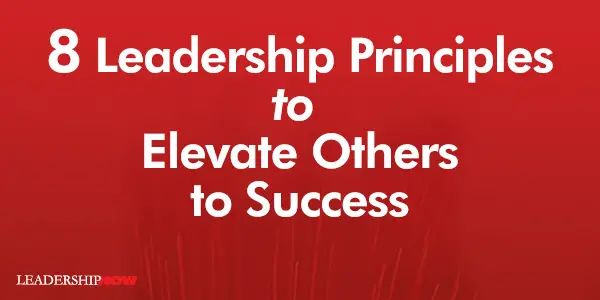
LEADERSHIP, says John Eades, is “inspiring, empowering, and service in order to elevate others over an extended period of time.” In Building the Best he tells how to do just that. To that end he presents 8 practical principles you can use to elevate others . Principle 1: Use High Levels of Love and Discipline to Elevate Others In terms of the workplace, Eades defines love as contributing to someone’s long-term success, and well-being and discipline as promoting standards in order for an individual to chose to be at his or her best. With love and discipline as a foundation, we can use the following seven principles to elevate others. Eades presents five leadership styles that we can fall into, but only high love and discipline will be effective in elevating others. You can take a free leadership style assessment on the LearnLoft website.
Principle 2: Without Strong Relationships, You Can’t Lead Leadership is relationships. Consistently demonstrating good character, showing you care for others, and your willingness to share your expertise with others builds trust with your team. Principle 3: Culture Starts with You, But Your People Prove It The cultural values you live will be evident in the behavior of your people. Four elements to consider when building a culture are safety ( emotionally safe), Unity (belonging and mutual respect), positivity (belief in possibilities), and energy (encouraged to produce and grow). Principle 4: People Persevere Because of Purpose Not Pay Purpose is derived from values, vision, and mission. “The most important thing frontline managers can do is connect their specific team to the purpose of their work.” By connecting people to the overarching purpose you elevate them to the possibilities their work contributes to the whole. Principle 5: Goals Aren’t Achieved Without Priorities Put into Action Break the goal down step-be-step. “To ensure you don’t unintentionally veer of course, come up with the top priorities that will help achieve your big goal.” Principle 6: The Instant You Lower Your Standards Is the Instant Performance Erodes Your standards define what an excellent culture looks like. “Standards produce behavior, behaviors become habits, and habits lead to results.” Principle 7: Accountability Is an Advantage, Make It Your Obligation Accountability often has a negative sound to it. But that is usually the result of the lack of accountability from the beginning. Accountability is meant to keep people on track and to exceed expectations. Feedback is done through direct dialogues. Eades offers systems to help do this right. “Being a leader of consequence, where accountability is at the center of everything you do, will lead to improved performance.” Principle 8: Coaching Unlocks Potential and Elevates Performance “While a team can function autonomously, a strong, dedicated leader plays an integral role in pushing people to new heights of development. They do this by focusing on coaching their people for role development and going beyond the role.” Eades provides a model for role development that shows you how to align your coaching to each of the for stages of role development. To maintain the mindset of elevating others, Eades urges us to say to ourselves as we go throughout our day, “Prepare to serve.” On your way to work, as situations change during the day, as you enter your house at night, think “prepare to serve.” Your attitude will be reflected in your leadership behavior. 
Posted by Michael McKinney at 07:56 AM
11.04.19

Sailing True North and the Voyage of Character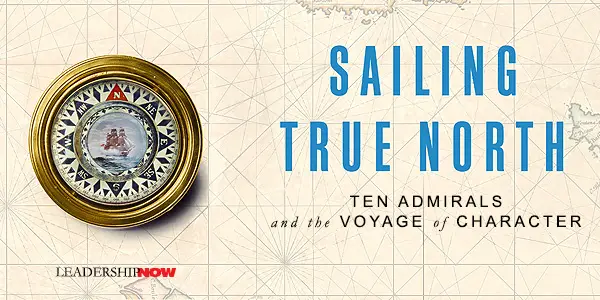
THERE IS NO SUBSTITUTE for character. Better systems, better laws can’t make up for it. Without good character, leaders can go south fast. The problem is that there is very little attention paid to how to develop good character. We learn best by example, but it is wise to look into the lives of others and understand the outcomes of their lives as a result of their character or lack of it. Four-star U.S. Navy Admiral and former Supreme Allied Commander of NATO James Stavridis gives us a comprehensive look at ten admirals in Sailing True North. He looks at their differing character traits and personalities and the effect it had not only on their careers but on those they lead. He begins 25oo years ago with the Greek Themistocles and moves forward to the lives of 14th-century Chinese admiral Zheng He, Sir Francis Drake, Horatio Nelson, Alfred Thayer Mahan, John Fisher, Chester Nimitz, Hyman Rickover, Bud Zumwalt Jr., and finally, Grace Hopper. While each of their voyages on the open sea was demanding, it was “vastly easier than the inner voyage we all must sail every day of our lives. That voyage of character is the most important journey each of us ever makes.” Stavridis writes this out of a growing sense that “in this postmodern era that we are witnessing the slow death of character, driven by a global culture that has turned increasingly away from classic values—honesty, commitment, resilience, accountability, moderation—to a world that moves at breakneck speed and refuses to slow down and consider what is right and just.” Sadly, he notes too that “we have lost the ability to hone our character in private, and our lives are on display seemingly from the moment we are born. We overshare publicly and under-reflect privately on what our individual voyages mean.” It is good for us to slow down and look at these lives and use what we learn to adjust the course of our lives to be the best we can be. There is much we can learn from others. Biographies provide us with feedback on our own lives in a most palatable way if we take the time to apply what we learn. None of these admirals was perfect, but we can learn from them all. “The nature of any human is not what they do when the choices are easy, and the metaphorical sun is shining, but rather what they do when the options are morally ambiguous, and the seas are rough.” Some of the navigational advice we can learn from the lives of these admirals is: A leader should avoid getting into a position where the only way to persuade an audience is by an almost magical feat of rhetoric. Stavridis shares ten character traits that he has learned from the admirals he showcases and from his own experience as an admiral. At the top of his list is creativity—“a willingness to embrace the new, despite the difficulties and challenges of doing so.” You must find a way to bring along the nonbelievers. Second is resilience. Learn from your experiences and set new goals and keep moving. Third, he lists humility. Arrogance is toxic to a leader. “It is a lot easier to be resilient when you are humble to begin with.” The fourth quality is the need to find balance in our lives. Most of the admirals he lists in the book failed this test. After all, ambition often drives the lack of balance in our lives. Fifth is honesty—“being truthful no matter the cost.” Make truth a habit. Sixth is empathy. “Most of us are terribly self-centered.” See outside yourself. “A virtuous person begins every encounter with the world not from their own perspective alone, but rather by trying to understand the situation, mindset, and challenges that others are facing.” Seventh is believing a sense of justice matters. Self-control is at work here. Eighth is decisiveness. Ninth is determination. Never give up, as Churchill said, “except in convictions of honor and good sense.” The final character trait he lists is perspective. We can’t take ourselves too seriously. “We need to understand that in the end we are but sailing in a tiny ship on the boundless sea.” A good sense of humor goes a long way toward maintaining a proper perspective. 
Posted by Michael McKinney at 12:01 AM
11.01.19

First Look: Leadership Books for November 2019Here's a look at some of the best leadership books to be released in November 2019. Don't miss out on other great new and future releases.
If we're not careful, loserthink would have us believe that every Trump supporter is a bigoted racist, addicts should be responsible for fixing the opioid epidemic, and that your relationship fell apart simply because you chewed with your mouth open. Even the smartest people can slip into loserthink's seductive grasp. This book will teach you how to spot and avoid it--and will give you scripts to respond when hollow arguments are being brandished against you, whether by well-intentioned friends, strangers on the internet, or political pundits. You'll also learn how to spot the underlying causes of loserthink, like the inability to get ego out of your decisions, thinking with words instead of reasons, failing to imagine alternative explanations, and making too much of coincidences.
For anyone who’s sought to create change, or felt sucked into the drama and chaos of a toxic work environment, this book will advance the notion that everyone at an organization is a leader – for good or for bad – and that leaders have tremendous power to influence those who follow their example. The quality of our leadership is based upon our intentions, energy, and presence. By emphasizing authorship, self-care, and response-ability (not responsibility) as leadership skills and therefore cultural amplifiers, Contagious You shows you how to walk the path of more effective leadership while navigating the road blocks in your way.
Organizational culture has undergone a seismic shift in the 21st century―and with it, the requirements of leadership. In Building the Best, LearnLoft CEO John Eades takes you on a journey of transformation that will equip you with the tools you need to become the kind of cutting-edge leader today’s workplace so urgently needs. “Leadership is about empowering, inspiring, and serving in order to elevate others over an extended period of time. You are the perfect person to live this out every day.” Eades’s powerful words form the backbone of this groundbreaking guide to cultivating leadership at its highest level.
Leaders today spend up to 90 percent of each day communicating to make good things happen in their organizations. They communicate with colleagues, customers, shareowners, creditors, regulators, advocates, and competitors. They influence culture, opportunity, risk-taking, and risk aversion. The stakes in this new communication environment are very high, driving home Winston Churchill’s statement: “The difference between mere management and leadership is communication.” Whether they recognize it or not, leaders are chief credibility officers, with organizational reputations often resting on their words and actions, especially in times of crisis. As a CEO quoted in the book said: “Communication shouldn’t be just another hat that a CEO wears. It should be at the core of everything you do.”
Despite the unprecedented connectivity enabled by modern technology, we are far less likely to trust and to invest the time needed to build strong relationships. How can we use technology to reverse this trend? A groundbreaking new branch of artificial intelligence―Personality AI―may be the answer. Combining traditional machine learning, data analytics, and behavioral psychology, Personality AI helps professional communicators tear down walls, establish trust with their audiences, and utilize data to build meaningful relationships, strengthen empathy, and win more customers.
The Age of Software is here, and another mass extinction event looms—this is a story about rebel developers and business leaders working together, racing against time to innovate, survive, and thrive in a time of unprecedented uncertainty...and opportunity. “My goal in writing The Unicorn Project was to explore and reveal the necessary but invisible structures required to make developers (and all engineers) productive, and reveal the devastating effects of technical debt and complexity. I hope this book can create common ground for technology and business leaders to leave the past behind, and co-create a better future together.” —Gene Kim
 Build your leadership library with these specials on over 39 titles. All titles are at least 40% off the list price and are available only in limited quantities. “It is a man’s duty to have books. A library is not a luxury, but one of the necessities of life.” — Henry Ward Beecher
Posted by Michael McKinney at 07:51 AM
|
BUILD YOUR KNOWLEDGE


How to Do Your Start-Up Right STRAIGHT TALK FOR START-UPS 
Grow Your Leadership Skills NEW AND UPCOMING LEADERSHIP BOOKS 
Leadership Minute BITE-SIZE CONCEPTS YOU CAN CHEW ON 
Classic Leadership Books BOOKS TO READ BEFORE YOU LEAD |
|